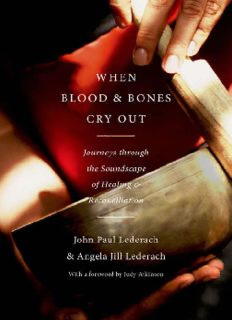
When Blood and Bones Cry Out: Journeys Through the Soundscape of Healing and Reconciliation PDF
Preview When Blood and Bones Cry Out: Journeys Through the Soundscape of Healing and Reconciliation
When Blood and Bones Cry Out This page intentionally left blank When Blood and Bones Cry Out Journeys through the Soundscape of Healing and Reconciliation JOHN PAUL LEDERACH ANGELA JILL LEDERACH 1 1 Oxford University Press, Inc., publishes works that further Oxford University’s objective of excellence in research, scholarship, and education. Oxford New York Auckland Cape Town Dar es Salaam Hong Kong Karachi Kuala Lumpur Madrid Melbourne Mexico City Nairobi New Delhi Shanghai Taipei Toronto With offi ces in Argentina Austria Brazil Chile Czech Republic France Greece Guatemala Hungary Italy Japan Poland Portugal Singapore South Korea Switzerland Thailand Turkey Ukraine Vietnam Copyright © John Paul Lederach and Angela Jill Lederach, 2010. All rights reserved. Foreword © Judy Atkinson 2010 First published by University of Queensland Press, PO Box 6042, St. Lucia, Queensland 4067, Australia. Published by Oxford University Press, Inc. 198 Madison Avenue, New York, New York 10016 www.oup.com Oxford is a registered trademark of Oxford University Press All rights reserved. No part of this publication may be reproduced, stored in a retrieval system, or transmitted, in any form or by any means, electronic, mechanical, photocopying, recording, or otherwise, without the prior permission of Oxford University Press. Library of Congress Cataloging-in-Publication Data Lederach, John Paul. When blood and bones cry out : journeys through the soundscape of healing and reconciliation / John Paul Lederach and Angela Jill Lederach. p. cm. Includes bibliographical references and index. ISBN 978-0-19-983710-6 1. Peace-building. 2. Mediation. 3. Reconciliation. 4. Forgiveness. 5. Confl ict management. I. Lederach, Angela Jill. II. Title. III. Title: Journeys through the soundscape of healing and reconciliation. HM1126.L435 2010a 327.1'72—dc22 2011009171 1 3 5 7 9 8 6 4 2 Printed in the United States of America on acid-free paper For Tom Cauuray, whose life and words inspired our writing, and for his family in the Falui Poets Society who faced the horrors of unfettered violence with the prophetic imagination of memory and hope; For the family of Efraín Arenas and Doris Berrio and the more than four million displaced and disappeared in the Colombian wars; For Morris Matadi and the thousands of child combatants on the journey to fi nd their way home; For Kadiatu Koroma and women everywhere who have the courage to give voice to the unspeakable devastation of sexual violence. This page intentionally left blank Contents Foreword ix Preface x v Introduction: social healing in the age of the unspeakable 1 SECTION I NARRATIVE REFLECTIONS 15 chapter 1 Drums and gardens 17 chapter 2 The wandering elders 23 chapter 3 The Women of Liberia Mass Action for Peace Campaign 28 chapter 4 The bones with no name 34 chapter 5 Shifting metaphors 41 SECTION II THE SONICS OF HEALING 73 chapter 6 Sonic survival 75 chapter 7 The Tibetan singing bowl 89 chapter 8 Following the healing muse 111 SECTION III THE WOMB OF CHANGE 145 chapter 9 When mothers speak 147 chapter 10 The poetry of social healing 170 SECTION IV THEORY, IMPLICATIONS AND CONCLUSIONS 195 chapter 11 The resonating echo of social healing 197 chapter 12 Conclusions 225 viii Contents Acknowledgements 235 Endnotes 239 References 241 Index 251 Foreword When I fi rst read the book M oral Imagination: The art and soul of building peace by John Paul Lederach, I felt the pull towards a kin- dred spirit, someone who knew something about where I had been and what I was doing in my life and work. John Paul had written in a way that connected with me. I felt he knew the landscape, often a rough, harsh terrain, over which I had been walking, and sometimes a moisture-rich valley of sounds, calling me to places where people desired to sit in the Dadirri1 circle, listening to and learning from each other. Later, when he sent me the draft manuscript for When Blood and Bones Cry Out: Journeys through the soundscape of healing and re conciliation, as I read, page by page, slowly, taking time to think, refl ect, and reconnect where I had been, I felt and heard that kindred soul speaking to me on another level. J ohn Paul observed that this writing project with his daughter Angie is ‘one of the most beautiful experiences a father could have’ . Perhaps even more so is to work with your children on things that matter. When Blood and Bones Cry Out links John Paul’s work in many places, but for this book, violence in Colombia links with that of his daughter Angie’s work with child soldiers in West Africa, com- ing home from their childhood war zone experiences. J ohn Paul writes about what he calls a neglected aspect of healing and reconciliation. We too often write about it as a linear process. Of
Description: